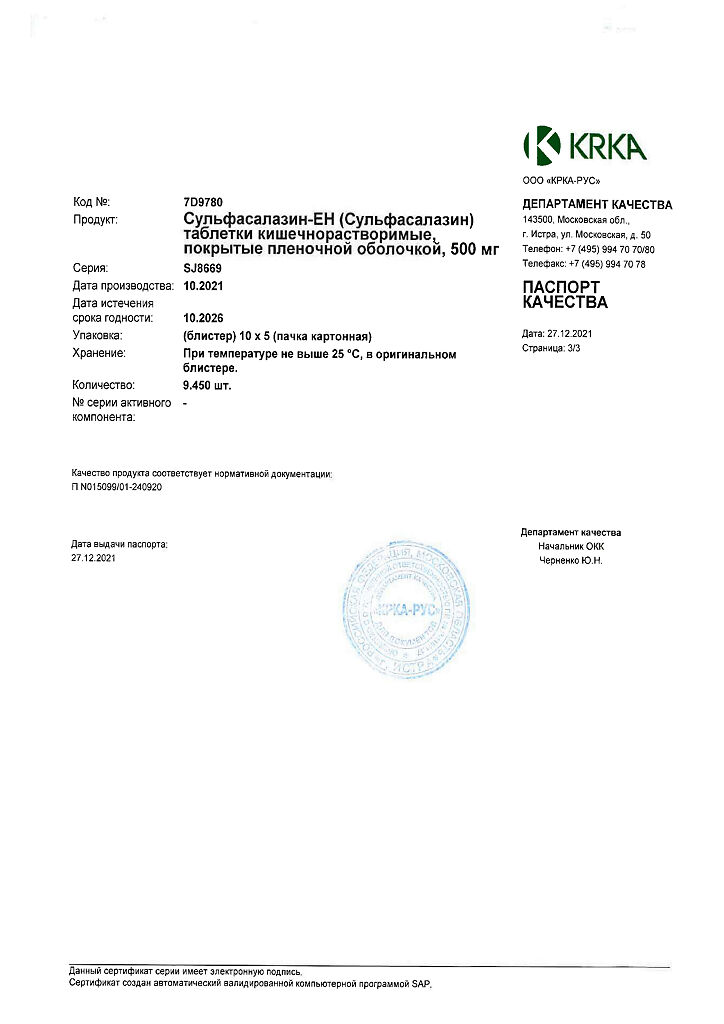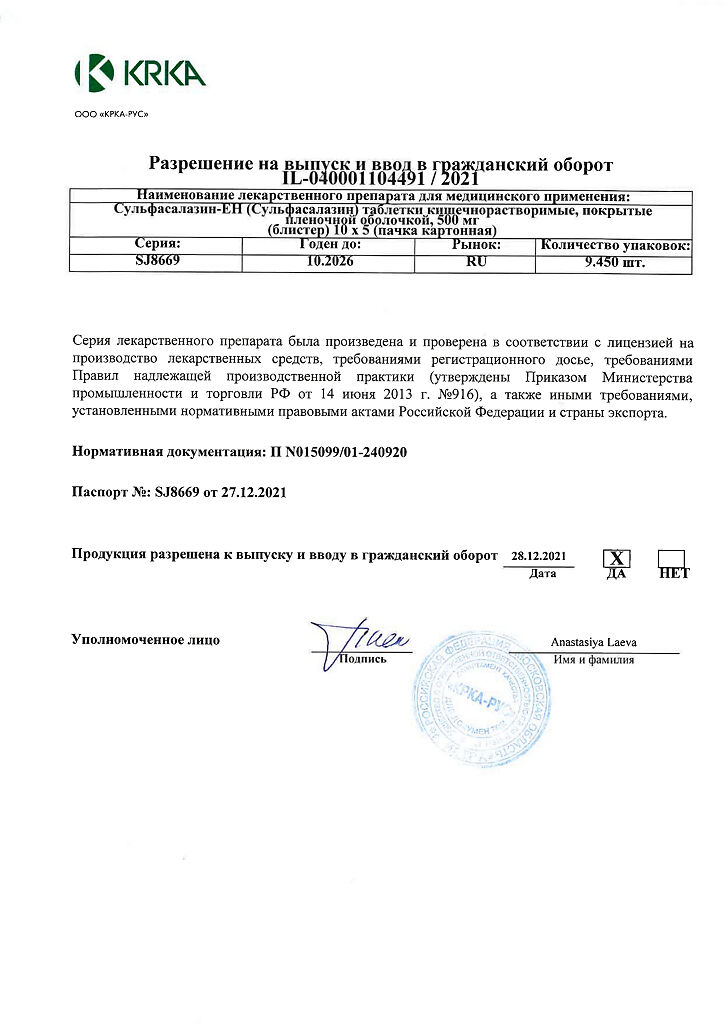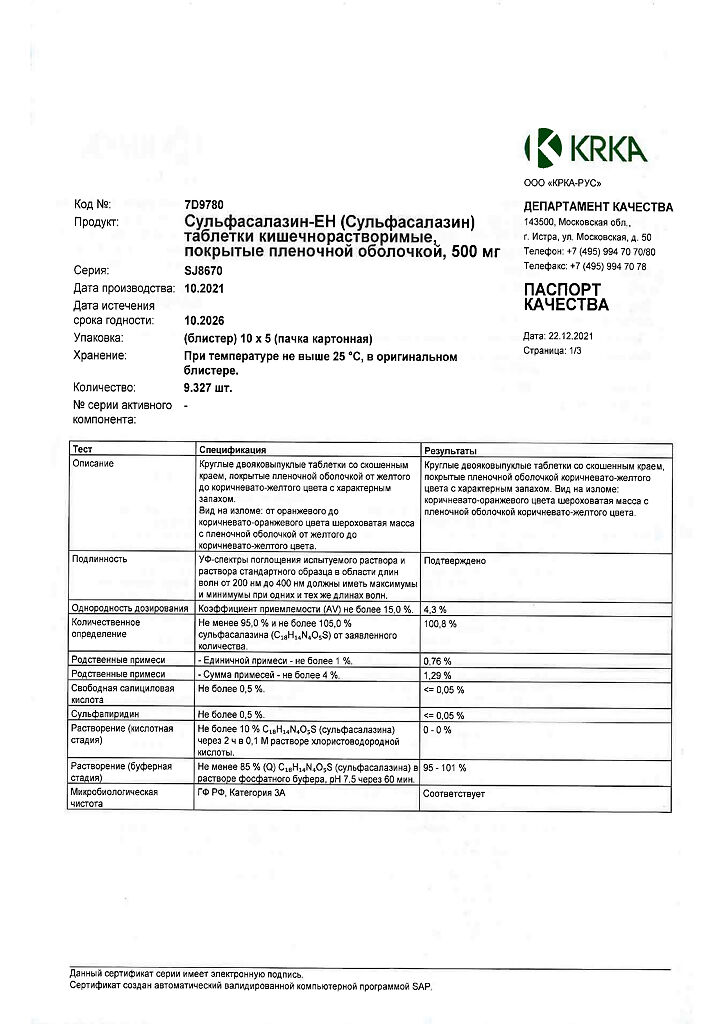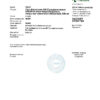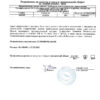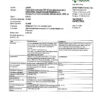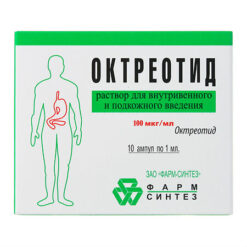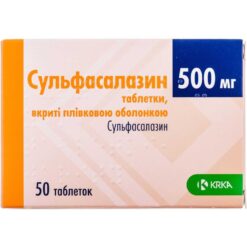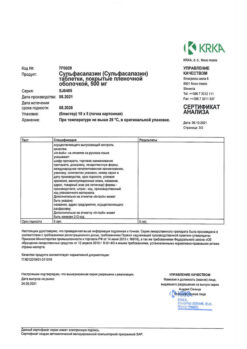No products in the cart.
Sulfasalazine-EN, 500 mg 50 pcs
€14.01 €11.68
Description
Sulfasalazine-EN is an antimicrobial and anti-inflammatory intestinal agent.
Sulfasalazine selectively accumulates in the intestinal connective tissue with release of 5-aminosalicylic acid (5-ASA), which has anti-inflammatory activity, and sulfapyridine, which has antimicrobial bacteriostatic activity against diplococci, streptococci, gonococci, E. coli.
Pharmacokinetics
About 30% of sulfasalazine in enteric-coated tablets are absorbed from the small intestine, the remaining 70% are cleaved by the intestinal microflora to form 60-80% sulfapyridine and 25% 5-ASC. Sulfasalazine reaches maximum concentration 3-12 hours after intake of enteric coated tablets. Sulfasalazine plasma protein binding is 99%, sulfapyridine – 50%, 5-ASC – 43%.
Sulfapyridine is metabolized in the liver by hydroxylation to form inactive metabolites, 5-ASC – by acetylation. Half-life of sulfasalazine is 5-10 hours, of sulfapyridine – 6-14 hours, of 5-ASC – 0.6-1.4 hours. Excretion through the intestine is 5% of sulfapyridine and 67% of 5-ASC, by the kidneys – 75-91% of the absorbed sulfasalazine (within 3 days).
Indications
Indications
Nonspecific ulcerative colitis (treatment of exacerbations and maintenance therapy in remission);
Crohn’s disease (mild and moderate forms in the acute phase);
Rheumatoid arthritis; juvenile rheumatoid arthritis.
Pharmacological effect
Pharmacological effect
Sulfasalazine-EN is an antimicrobial and anti-inflammatory intestinal agent.
Sulfasalazine selectively accumulates in the connective tissue of the intestine with the release of 5-aminosalicylic acid (5-ASA), which has anti-inflammatory activity, and sulfapyridine, which has antimicrobial bacteriostatic activity against diplococci, streptococci, gonococci, and E. coli.
Pharmacokinetics
About 30% of sulfasalazine in enteric-coated tablets is absorbed from the small intestine, the remaining 70% is broken down by intestinal microflora to form 60-80% sulfapyridine and 25% – 5-ASA. Sulfasalazine reaches maximum concentration 3-12 hours after taking enteric-coated tablets. Plasma protein binding of sulfasalazine – 99%, sulfapyridine – 50%, 5-ASA – 43%.
Sulfapyridine is metabolized in the liver by hydroxylation to form inactive metabolites, 5-ASA by acetylation. The half-life of sulfasalazine is 5-10 hours, sulfapyridine – 6-14 hours, 5-ASA – 0.6-1.4 hours. Excreted through the intestines – 5% of sulfapyridine and 67% of 5-ASA, by the kidneys – 75-91% of absorbed sulfasalazine (within 3 days).
Special instructions
Special instructions
During the treatment period, periodic monitoring of the level of “liver” enzymes in the blood plasma, a general blood test (at the beginning of therapy: 1-2 times a month, then every 3-6 months of treatment) and a urine test (in case of renal failure), and drinking increased amounts of fluid are recommended.
Sulfasalazine is recommended to be prescribed with caution to patients with systemic forms of juvenile rheumatoid arthritis, because there is a risk of developing undesirable effects, incl. serum sickness (fever, nausea, vomiting, headache, rash and liver dysfunction).
Effect on the ability to drive a car and other mechanical means: there have been no reports of a significant effect of Sulfasalazine-EN on the ability to drive a car or other mechanical devices.
Active ingredient
Active ingredient
Sulfasalazine
Composition
Composition
1 enteric-coated tablet contains:
active ingredient:
sulfasalazine,
povidone coated (equivalent to 500 mg sulfasalazine) 535,000 mg
excipients:
pregelatinized starch,
magnesium stearate,
colloidal silicon dioxide,
anhydrous.
Pregnancy
Pregnancy
During pregnancy, the drug can be prescribed only according to strict indications and in the minimum effective dose. If the course of the disease allows, then in the last trimester of pregnancy the drug should be discontinued.
If it is necessary to prescribe Sulfasalazine-EN during lactation, the issue of stopping breastfeeding should be decided.
Contraindications
Contraindications
Hypersensitivity to sulfasalazine or other components of the drug Sulfasalazine-EN, as well as sulfonamides or salicylates;
porphyria;
granulocytopenia;
aplastic anemia;
congenital deficiency of glucose-6-phosphate dehydrogenase (risk of developing jaundice);
liver and/or kidney failure;
children under 10 years of age and/or weighing 35 kg with chronic inflammatory bowel disease; children under 6 years of age with juvenile rheumatoid arthritis (for this dosage form and dosage) (efficacy and safety have not been proven);
lactation period.
With caution: bronchial asthma, history of allergic reaction (possible cross-allergic reaction to furosemide, thiazide diuretics, sulfonylurea derivatives, carbonic anhydrase inhibitors), systemic forms of juvenile rheumatoid arthritis (risk of developing serum sickness); pregnancy.
Side Effects
Side Effects
Side effects are related to the degree of plasma concentration of sulfapyridine, especially in people with slow acetylation. Side effects are more common in patients with rheumatoid arthritis.
From the central and peripheral nervous system: headache, peripheral neuropathy, vertigo, dizziness, hallucinations, convulsions, ataxia, sleep disturbance, depression, aseptic meningitis.
From the gastrointestinal tract: nausea, vomiting, diarrhea, loss of appetite, pancreatitis, stomatitis, abdominal pain, drug-induced hepatitis.
From the hematopoietic organs: macrocytosis, leukopenia, neutropenia, megaloblastic anemia, hemolytic anemia, hemolytic anemia due to enzyme disorders – with unstable hemoglobin molecules (Heinz-Ehrlich bodies), methemoglobinemia, agranulocytosis, thrombocytopenia, selfish anemia, hypoprothrombinemia.
From the genitourinary system: proteinuria, hematuria, crystalluria, nephrotic syndrome, transient oligospermia and infertility.
From the respiratory system: shortness of breath, cough, interstitial pneumonitis, fibrosing alveolitis, infiltrates in the lung tissue.
From the senses: tinnitus.
Laboratory data: hyperbilirubinemia, increased activity of alkaline phosphatase, “liver” transaminases.
Allergic reactions: generalized skin rash, urticaria, erythema, pruritus, exfoliative dermatitis, photosensitivity, toxic epidermal necrolysis (Lyell’s syndrome), malignant exudative erythema (Stevens-Johnson syndrome), fever, lymphadenopathy, serum sickness, periorbital edema, eosinophilia, polyarteritis nodosa, anaphylactic shock.
Other: hyperthermia, mumps, possible yellow-orange staining of urine, skin or soft contact lenses.
Interaction
Interaction
Sulfasalazine reduces the absorption of folic acid and digoxin. Enhances the effect of anticoagulants, antiepileptic and oral hypoglycemic drugs, as well as the side effects of cytostatics, immunosuppressants, hepato- and nephrotoxic drugs.
Medicines that inhibit bone marrow hematopoiesis increase the risk of myelosuppression.
Antibiotics, due to their inhibitory effect on the intestinal flora, reduce their effectiveness in ulcerative colitis.
Overdose
Overdose
Symptoms: nausea, vomiting, abdominal pain, dizziness. When using very high doses, the following may occur: anuria, crystalluria, hematuria, symptoms of toxic damage to the central nervous system (convulsions).
Treatment: symptomatic. It is necessary: induce vomiting, rinse the stomach and intestines; carry out alkalization of urine, forced diuresis. For anuria and/or renal failure: fluid and electrolyte intake should be limited.
Storage conditions
Storage conditions
At a temperature not exceeding 25 °C.
Shelf life
Shelf life
5 years
Manufacturer
Manufacturer
KRKA dd Novo Mesto, Slovenia
Additional information
| Shelf life | 5 years |
|---|---|
| Conditions of storage | At a temperature not exceeding 25 ° C. |
| Manufacturer | KRKA dd Novo mesto, Slovenia |
| Medication form | pills |
| Brand | KRKA dd Novo mesto |
Related products
Buy Sulfasalazine-EN, 500 mg 50 pcs with delivery to USA, UK, Europe and over 120 other countries.


